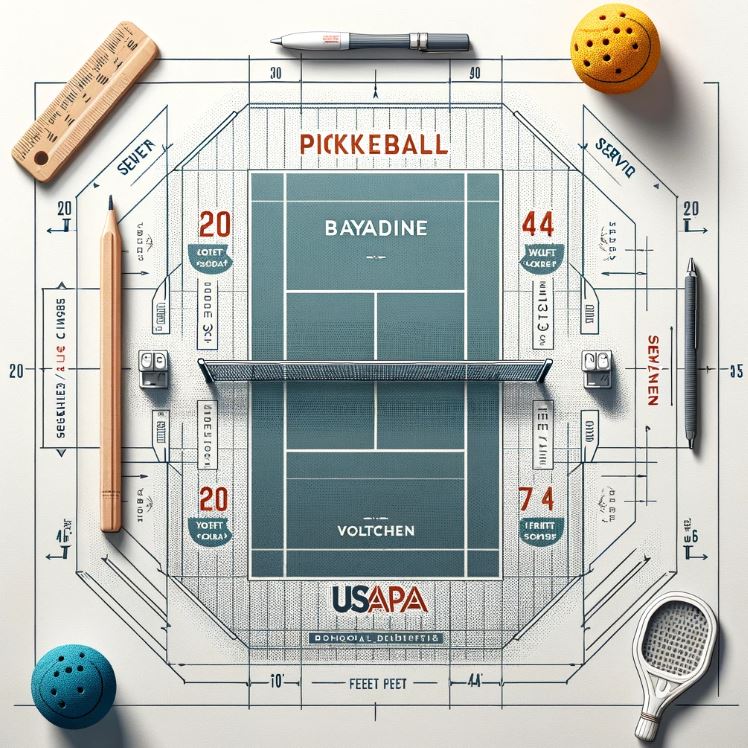I'm a participant in the Amazon Services LLC Associates Program, an affiliate advertising program designed to provide a means for me to earn fees by linking to Amazon.com and affiliated sites.
Pickleball is a fast-growing sport that blends elements of tennis, badminton, and ping-pong. Understanding the dimensions and layout of a pickleball court is crucial for players, whether they are setting up a court at home or preparing for a game at a local facility. This article will provide a detailed look at the size of a pickleball court, including official dimensions, layout, and recent developments in court design. How big is a pickleball court? Soon you’ll know.
Need help finding the right paddles? Here we cover which paddles rank near the top.
Key Takeaways
- A standard pickleball court is 20 feet wide and 44 feet long.
- Court layout includes specific markings for the kitchen, service areas, and baseline.
- Recent advancements in court design and materials enhance playing conditions.
Official Dimensions of a Pickleball Court
Overall Size
A standard pickleball court measures 20 feet wide by 44 feet long for both singles and doubles play. These dimensions are the same as a doubles badminton court and are significantly smaller than a tennis court, making pickleball more accessible for players of all ages and skill levels.
Key Areas
- Baseline: The boundary line at the ends of the court, running parallel to the net.
- Sidelines: The boundary lines running perpendicular to the net.
- Non-Volley Zone (Kitchen): A 7-foot area on both sides of the net where volleying is not allowed.
- Service Courts: Divided into left and right service areas by a centerline, each service court is 10 feet wide and extends from the non-volley zone to the baseline.
Net Height
The net height is 36 inches at the sidelines and 34 inches at the center. This lower net height compared to tennis makes the game more accessible and fast-paced.
Court Markings
Court markings are essential for proper gameplay. They include lines for the baseline, sidelines, non-volley zone, and service areas. These lines should be 2 inches wide and clearly visible.
Recent Developments in Pickleball Court Design
The popularity of pickleball has led to innovations in court design and materials. Some recent developments include:
- Modular Court Surfaces: Companies are now offering modular court surfaces that can be easily installed and provide better traction and cushioning.
- Portable Nets: Advances in portable net systems allow for easy setup and takedown, making pickleball more accessible in various locations.
- LED Lighting: Improved lighting solutions enhance visibility for night play and indoor courts, ensuring consistent playing conditions.
Top Experts and Entities in Pickleball
USA Pickleball Association (USAPA)
The USAPA sets the official rules and standards for pickleball courts in the United States. They provide guidelines for court dimensions, equipment, and setup, ensuring consistency across the sport.
Pickleball Central
As a leading retailer and resource hub, Pickleball Central offers extensive information on court setup and maintenance. They provide reviews and recommendations for court surfaces, nets, and other equipment.
Professional Players
Top professional players, such as Ben Johns and Simone Jardim, often share insights into court preferences and setups, offering valuable tips for enthusiasts looking to optimize their playing environment.
Key Takeaways – How Big Is a Pickleball Court?
- The standard size of a pickleball court is 20 feet by 44 feet.
- Essential areas include the baseline, sidelines, non-volley zone, and service courts.
- Recent innovations in court design improve playability and accessibility.
Internal Links
- Best Protein Bars for Weight Loss 2024
- When Do Protein Bars Expire?
- Recipe for Protein Bars with Peanut Butter
- Unhealthiest Protein Bars 2024
- Protein Bars Before or After Workout
Author
This article is written by Trimflo, an expert in the field of pickleball equipment with many years of experience.
Understanding the dimensions and layout of a pickleball court is essential for setting up and enjoying the game. Whether you are a beginner or an experienced player, knowing the court specifics can enhance your playing experience and ensure you adhere to official guidelines.
